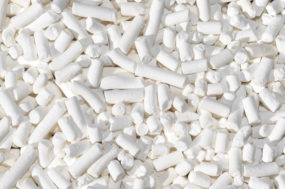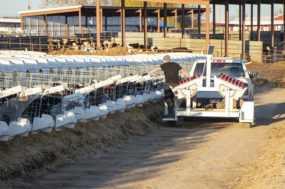Fiber is a key component of the ruminant diet and can frequently account for over 50 percent dry matter intake through the inclusion of silage, hay and fibrous co-products.
However, forage composition and quality can differ significantly, which can lead to variation in digestibility and impact animal performance.
Since buying better-quality hay or feed isn’t always an option, innovations in fiber utilization are of increasing interest due to their ability to release valuable energy from the diet that was previously unavailable.
One innovation is a new liquid pre-treatment from AB Vista Inc. that starts to digest fiber before it hits the feedbunk. This helps cows to maximize fiber and forage digestion, and ultimately increase milk yield.
“VistaPre-T is forage pre-treatment that works to break down the cellulose, hemicellulose and amylose fractions of the feed,” says Ian Lean, adjunct professor at the University of Sydney and managing director at SBScibus. “It works like enzymes in the rumen to break down feed and make that feed more available to the animal.”
The pre-treatment extracts new value from homegrown forage and other fibrous feeds otherwise unavailable to the rumen.
“The most costly nutrients in the ration are those that pass through the animal without being digested,” says Bruce Hageman, North American commercial manager at AB Vista. “With this treatment, we are able to liberate more of those nutrients through digestion and provide access to the most cost-effective sources of nutrients contained in forage.”
The treatment is applied directly onto the TMR as a liquid and begins to work immediately to break down the surface of the fiber, enabling pre-digestion of the forage before it is consumed. Once applied, it causes pits to form on the surface of the plant material, thus roughening and increasing the surface area for attachment by rumen-degrading microbes.
Hageman says the treatment begins to work in approximately five minutes in terms of its enzymatic action and levels out at about 55 minutes. These physical changes reduce the lag time to digestion and increase feed digestibility, allowing for greater feed utilization.
“What it ultimately does is make it easier for the animal to digest forages and extract nutrients from the fiber in the ration. Therefore, the feed becomes more efficient in terms of their digestive process,” Hageman says. “Typically, what we will see with this additional energy now available to the animal is an increase in milk production as well as fat and protein components.”
While conducting meta-analytical research to look at alternative products to increase the efficiency of rumen and milk production, Lean was approached by the company to undertake a research project to evaluate the liquid pre-treatment.
The research involved dairies from several different continents to trial the product. One of the farms involved in the project in the U.S. was Drumgoon Dairy in Lake Norden, South Dakota.
“We put out feelers for farms that would be a good site for a research conduct,” Lean says. “We talked to the Elliott family and went through their farm history, had a look at their record-keeping and identified they were willing to do the study. They were willing to do it, and that is how we formed our relationship.”
The goal of the study was to take a more in-depth look at the product’s ability to increase milk production and milk solids as well as the impact on health and reproduction, says Lean.
The research trial on Drumgoon Dairy studied, in total, 2,000 head of cattle. In two pens, 1,000 cows were fed the liquid pre-treatment, and another two pens of 1,000 cows were the control group. The trial ran for 11 months and ended in December 2016.
For the study, Drumgoon Dairy utilized a micro-mixing machine to apply the liquid pre-treatment to the mixer wagon. The application rate of the treatment was 750 milliliters per ton of total dry matter.
Milk production from the research trial was tracked through daily milk records, and milk solids were followed using DHIA test reports. From the farm data collected, Lean also observed reproduction characteristics and health issues.
As a result of the liquid pre-treatment, the study showed an increase in milk yield of 2.8 pounds per cow per day. The researchers also saw a decrease in dry matter intake by 1.32 pounds per day per cow and an average increase in bodyweight of 8.8 pounds.
“The interesting thing was: We saw both increases in milk yield and bodyweight without seeing any increased feed intake,” Lean says. “This is really important because it means we increased efficiency.”
After finishing the research trial, the dairy decided to continue selectively using the treatment because of the positive results seen in the herd.
“We saw quite a big milk response in the post-fresh animals,” says David Elliott, operations manager at Drumgoon Dairy. “The first 60 to 70 days the animals were on VistaPre-T were drastically outperforming the control string. We saw probably a 6-pound difference. We saw this product was something that worked, and we wanted to keep using it.”
Previously, Drumgoon Dairy had been feeding the treatment to all lactating and non-lactating cows.
“With how milk prices are now, we don’t have it in the dry cow ration or the late-lactation ration anymore. We just have it in the close-up ration,” Elliott says. “We didn’t think we saw as big of a response in milk in the late lactation. However, I know when we took it out, we took quite a severe dip in milk production, but it seemed to rally. I’m guessing more favorable weather for milk is the reason it rallied.”
Elliott estimates the cost of the treatment is about 19 cents per cow on his farm.
“It kind of is quite an expensive product, to be completely honest. It is probably why other dairies are hesitant to use it,” Elliott says. “If milk was 2 dollars per hundredweight higher, I’d probably still have it in all my rations.”
The Elliott family were wonderful collaborators to work with, and they ensured the study was of high quality, Lean says.
“I’d have to say, so far the results are extremely positive,” Lean says. “We think the product has got a positive future because of the ability it has to increase the efficiency of production while not requiring extra feed, which is very important for dairymen and the high-pressure environment in America at the moment.” ![]()

-
Audrey Schmitz
- Editor
- Progressive Dairyman
- Email Audrey Schmitz







